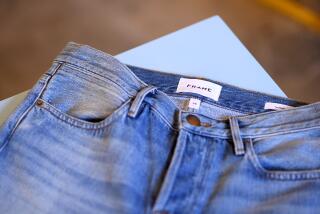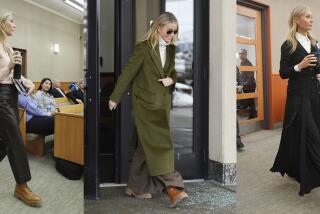Everlane’s ‘radical transparency’ is e-tailer’s strong suit
- Share via
What does a celebrity get out of a partnership with a consumer brand? In the case of e-tailer Everlane’s collaboration with Mariel Hemingway’s daughter Langley Fox, the cut is precisely $2.80 per $28 cotton slub tank top.
We know that because the San Francisco-based, Web-only purveyor of well-made, low-cost apparel and accessories doesn’t just disclose the information, it also showcases it in an easy-to-understand infographic on its website — alongside the cost of materials ($2.65), labor ($6.90), transportation (20 cents) for a cost (rounded up to the nearest dollar) of $13, with a markup of $15.
Everlane lists the same cost/markup breakdown for every straight-to-consumer product it sells, part of a brand strategy it calls “radical transparency” — essentially playing the honesty card in all facets of its business. Everlane taps into the conscious consumerism zeitgeist by not only serving up the locations and descriptions of its supplying factories — which span the globe from eastern China to Northern California — but also by attempting to forge a deeper, more emotional connection by including details such as real-time weather conditions and the local time of each locale. The resulting effect on a jaded e-customer is not unlike that when one stumbles into an honest relationship after dating a string of serial cheaters.
All that back story is buttressed by an ever-growing collection of chic, simple staples for men and women: drapey, minimalist V-neck T-shirts ($15); twill snap backpacks ($65); slouchy cashmere cardigans ($140); silk, round-collar blouses ($78); short, swingy trench coats ($138); Italian leather sandals ($118) and belts ($40) with an almost Céline-like spare appeal.
The line is heavy on solid colors, light on patterns, all of it remarkably unremarkable to look at but with the unmistakable feel of luxury. Add that many of the goods are crafted in the same factories that manufacture well-known luxury brands, and Everlane’s wares approach the kind of so-understated-they’re-cool “normcore” objects that might be found in hipster havens such as Silver Lake and Park Slope.
So far that honesty-is-the-best-policy, low-priced-luxe approach appears to be paying off. Everlane founder and Chief Executive Michael Preysman (who comes from a private equity and tech background, not a fashion one) said that annual revenue growth is strong and that the company is on track to do 2 1/2 times more business this year than it did in 2013.
Pam Danziger, a luxury market researcher and founder of Unity Marketing, said Everlane is one of a handful of companies that are successfully tapping into the less-is-more movement among affluent consumers.
“It’s [moving] away from all the froufrou and the blingy logos,” said Danziger. “And what I admire about Everlane is that they’ve done such a great job in terms of telling their story. It’s one of a number of companies that are making it real.”
Preysman said he sees lots of growth opportunity.
One area of growth is inventory expansion. “We have 45 [different] styles of items today,” Preysman said. “We want that to be 200 by next year.”
The Everlane Langley Fox tanks, which debuted in July, are one example of how the brand is continually adding new items. The two sleeveless cotton T-shirts ($24 and $28) were designed by Ernest Hemingway’s 25-year-old model/artist great-granddaughter, a longtime friend of the brand and one of its first models.
“It totally blew through our expectations,” Preysman said. “We sold over 2,000 tanks in the first day.”
But Everlane still faces the same hurdle faced by other online fashion companies.
“Our No. 1 challenge is making people feel comfortable buying clothes online from a brand they’ve never heard of,” Preysman said.
Twitter: @ARTschorn
More to Read
Sign up for The Wild
We’ll help you find the best places to hike, bike and run, as well as the perfect silent spots for meditation and yoga.
You may occasionally receive promotional content from the Los Angeles Times.







